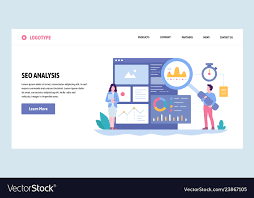
Search Engine Optimization (SEO) and website design are two crucial elements that work hand in hand to create a successful online presence. While many businesses focus solely on one or the other, the true magic happens when these two components are seamlessly integrated.
SEO website design involves creating a website with both user experience and search engine visibility in mind. It goes beyond just aesthetics and functionality to ensure that every aspect of the site is optimized for search engines like Google, Bing, and others.
SEO website design is not just about making your site look good; it’s about making sure it performs well too. By combining the principles of SEO with thoughtful design elements, you can create a website that not only attracts visitors but also converts them into customers. Invest in SEO website design today and watch your online presence soar!
SEO website design is a strategic approach to building and structuring a website that focuses on both user experience and search engine visibility. It involves incorporating SEO best practices into the design process to ensure that the site is easily discoverable by search engines and ranks well in search results. By optimising elements such as page titles, meta descriptions, headings, content quality, site speed, mobile responsiveness, and site structure, SEO website design aims to create a seamless user experience while also improving the site’s visibility and performance in organic search.
SEO website design plays a crucial role in influencing search engine rankings. When a website is optimised for SEO, it sends signals to search engines that it is relevant, trustworthy, and valuable to users. Elements such as keyword-optimised content, meta tags, site structure, mobile responsiveness, and page loading speed all contribute to a website’s SEO performance. By implementing SEO best practices into the design of a website, businesses can improve their visibility in search engine results pages (SERPs) and attract more organic traffic. Ultimately, SEO website design helps websites climb higher in search rankings, making them more likely to be discovered by users searching for relevant information or products online.
User experience plays a pivotal role in SEO website design as it directly impacts how visitors interact with a website and influences their decision to stay or leave. Search engines like Google prioritise user satisfaction by favouring websites that provide a positive browsing experience. A well-designed website that is easy to navigate, loads quickly, and offers valuable content not only keeps users engaged but also signals to search engines that the site is relevant and trustworthy. By focusing on user experience in SEO website design, businesses can improve their search engine rankings, increase organic traffic, and ultimately drive conversions.
When it comes to creating an SEO-friendly website design, several key elements play a crucial role in enhancing search engine visibility and user experience. These elements include optimising page titles, meta descriptions, and headings with relevant keywords to improve search engine rankings. High-quality and valuable content that answers users’ queries is essential for engaging visitors and boosting SEO performance. Ensuring fast loading times by optimising images and code, making the site mobile-friendly, having a clear site structure with easy navigation, and regularly monitoring performance are also vital components of an SEO-friendly website design that can contribute to its success in the digital landscape.
Improving your website’s loading speed is crucial for enhancing SEO performance. To boost your site’s loading speed, consider optimizing image sizes, minifying CSS and JavaScript files, enabling browser caching, and leveraging content delivery networks (CDNs). Additionally, ensure that your web hosting provider offers sufficient server resources to handle traffic efficiently. By prioritizing fast loading times, you not only provide a better user experience but also signal to search engines that your site is reliable and worthy of higher rankings in search results.
Mobile responsiveness is indeed essential for SEO website design. With the increasing number of users accessing websites on mobile devices, search engines like Google prioritise mobile-friendly sites in their rankings. A responsive design ensures that your website adapts seamlessly to various screen sizes and devices, providing a positive user experience regardless of how visitors access your site. By prioritising mobile responsiveness in your SEO website design, you not only improve usability but also enhance your chances of ranking higher in search engine results pages, ultimately driving more organic traffic to your site.
The role of content quality in SEO website design is paramount. High-quality content is the backbone of a successful SEO strategy, as search engines like Google prioritise websites that provide valuable, relevant, and engaging content to users. Well-crafted content not only attracts visitors but also keeps them on the site longer, reducing bounce rates and increasing the likelihood of conversion. By incorporating targeted keywords naturally within informative and compelling content, businesses can not only improve their search engine rankings but also build credibility and authority within their industry. In essence, content quality is not just a component of SEO website design; it is the driving force behind organic visibility and user engagement.
Measuring the effectiveness of your SEO website design efforts is essential to gauge the success of your online presence. One way to assess this is through monitoring key performance indicators (KPIs) such as organic traffic, keyword rankings, bounce rate, conversion rate, and time on page. By analysing these metrics regularly using tools like Google Analytics and Search Console, you can track the impact of your SEO strategies on your website’s visibility and user engagement. Additionally, conducting A/B testing, user surveys, and heatmaps can provide valuable insights into how users interact with your site and help identify areas for improvement in your SEO website design approach.